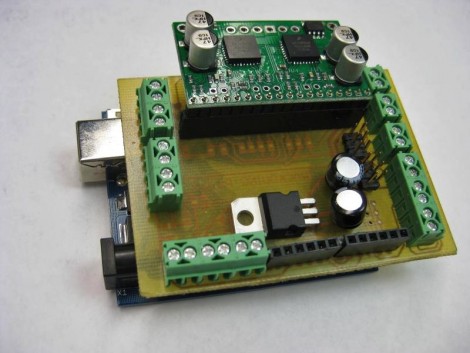
There’s really nothing special about this hack. [Craig Hollabaugh] needed an Arduino shield for hosting a Pololu motor driver and making connections to external hardware. What really caused us to spend way too much time reviewing his posts is that [Craig’s] narrative style of documenting the project is delightful, and we’re envious of his electronics lab. That link points to the first of four project pages. The next page is linked at the bottom of each page, or you can find the collection after the break.
[Craig] starts by designing a single-sided shield in Eagle. It’s been years since he made his own PCB, and it takes him about four tries to get the toner transfer right (we’ve also been victim to the wrong mirroring of the resist!). When it comes time to drill for the pin headers [Craig] uses his 3D printer to make a bracket allowing the Dremel to mount to the drill press. There’s a good tip here about buying carbide bits from Harbor Freight; we thought eBay was the only place to get these. Many of us would need to put in a parts order, but this workshop has a well-organized stock of everything he needs. He also has the solder paste and PID outfitted toaster oven to reflow the board. Oh, and when he forgets to add a resistor it’s off the rework station to add one.
See what we mean… one can never have too many tools.














I would suggest using CPM6.3 paper for toner transfer.
For example, this transfer uses 6mil traces:
http://www.todopic.com.ar/foros/index.php?action=dlattach;topic=36566.0;attach=17147;image
Link requires registration.
I found CPM6.3 here, http://www.themagictouchusa.com/p168/CPM63-Legal-%3Cbr%3E-Heat-Transfer-Paper/product_info.html
It’s a little ironic that’s he’s buying carbide bits from harbor freight and yet has (what looks to be)a $30k 3d printer. . . It certainly is a well-stocked (and equipped) workshop :-)
I get bits from drill bit city II I prefer them over harbor freight because you can actually choose the bits you’re buying, vs. the “assortments” at HF.
They also sell kits of different sizes here including nice wire-gauge and PCB-kits.
Whoa – where did he get those mini interlocking parts storage containers!?
Adafruit has them: http://www.adafruit.com/products/427
Adafruit sells them:
https://www.adafruit.com/products/427
I have tons, work well with digikey labels:
http://twitpic.com/6jitzp
http://iteadstudio.com/store/index.php?main_page=product_info&cPath=29_33&products_id=79
Adafruit also sells several colors/sizes of these boxes (http://www.adafruit.com/category/54), and you can find them with a quick ebay search for “component box” or similar terms as well.
I wonder if he has adjoining metal,and wood shops as nicely appointed as his electronics shop lab? Nice to see the fished project controlling the motors it’s supposed to control.
IMHO boards that you etch yourself greatly benefit from pouring a ground plane. The etching process is much faster. The etchant becomes less contaminated with copper as well. To top it off it will help reject EMI. It’s really easy to do in EagleCAD. Pretty much just pour a polygon on top, connect it to the ground net and hit the ratsnest button.
. . .oops, hit “report” instead of reply. . .sorry about that
Evenly removing copper is generally easier on the process, even on professionally fab’ed PCB’s. This is why you’ll notice that there is usually cross hatching on panels between PCB’s (if you’ve ever seen a full panel of boards).
Just love that shot of someone else’s TQFP-100 package FPGA, soldered to a home-made ‘board. Gives me hope for future projects. :)